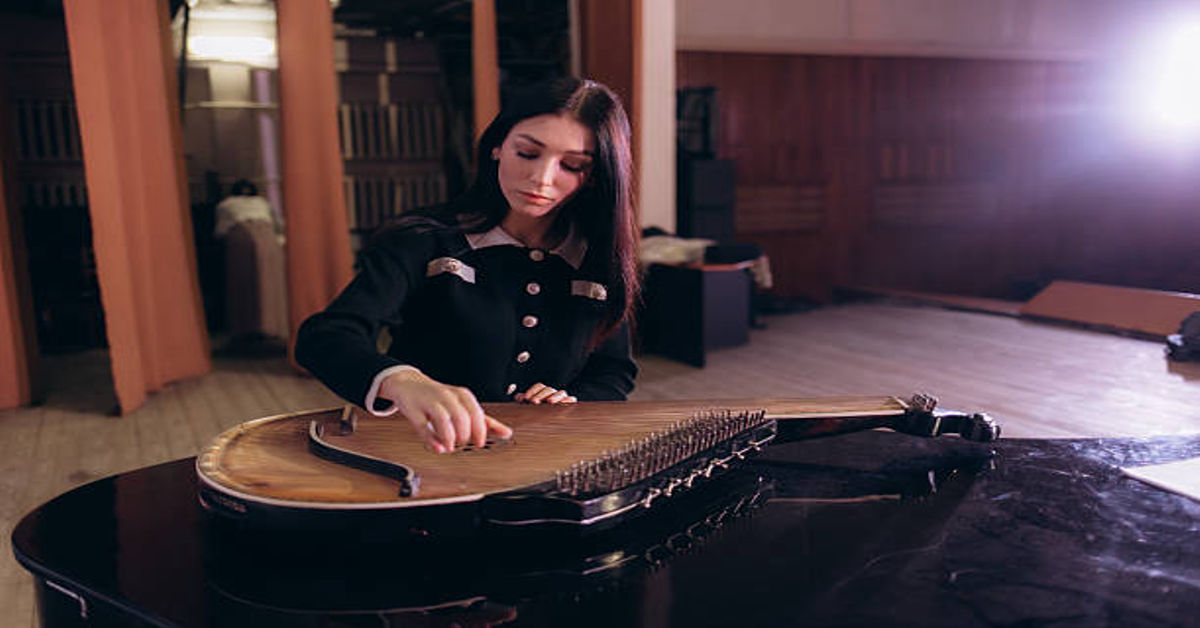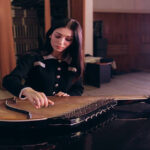The autoharp is one of the most fascinating and melodious string instruments ever created. Its sweet, resonant tones and ease of playing have made it a beloved choice for folk musicians, educators, and hobbyists alike. While many people recognize its gentle, harp-like sound, few truly understand its design, evolution, and the depth of musical expression it offers.
In this comprehensive 3,000-word article, we’ll explore everything about the autoharp—from its historical origins and structure to playing techniques, tuning methods, cultural significance, and maintenance tips. We’ll also include tables that clearly explain types, tunings, and chord arrangements, making this a valuable resource for anyone who wishes to learn more about this unique and underrated instrument.
1. What is an Autoharp?
The autoharp is a chorded zither, meaning it belongs to the family of stringed instruments that produce sound by vibrating strings stretched over a flat soundboard. Unlike traditional harps, the autoharp doesn’t have a curved frame or open strings for plucking individually. Instead, it uses chord bars that mute unwanted strings, allowing the player to strum a specific chord with ease.
Typically, the autoharp has 36 or 37 strings and anywhere from 12 to 21 chord bars. When a player presses a chord bar, it dampens all strings not required for that chord. The result is a full, harmonious sound that can accompany singing or stand beautifully on its own.
The instrument is played either by holding it upright against the chest and strumming with the right hand (as in traditional folk style) or by placing it flat on a table or lap for more controlled plucking.
2. History of the Autoharp
2.1 Early Development
The origins of the autoharp trace back to the late 19th century. Although the exact inventor is debated, it is generally agreed that Charles F. Zimmermann, a German-born American, patented a version of the instrument in 1882. His design introduced a chord mechanism over a zither-like base, which became the foundation for the modern autoharp.
However, Zimmermann’s version differed from what we recognize today—it was more of a conceptual hybrid. The practical version of the autoharp, featuring dampers controlled by buttons, was perfected by Karl August Gütter in Germany shortly after Zimmermann’s patent.
2.2 Growth in Popularity
By the early 1900s, the autoharp gained traction in America through companies like Oscar Schmidt, which mass-produced the instrument. It became especially popular in schools and churches because it was easier to learn than other stringed instruments.
2.3 Folk Revival Era
During the 1950s and 60s, the autoharp found a new voice in the American folk music revival. Musicians like Maybelle Carter of The Carter Family elevated it to prominence, using it to accompany her soulful Appalachian songs. Since then, it has become a symbol of American folk heritage.
2.4 Modern Era
Today, autoharps are used not only in folk and country genres but also in classical, contemporary, and even experimental music. Their portability and gentle resonance make them an enduring favorite among educators, performers, and collectors.
3. Structure and Design of the Autoharp
The autoharp’s beauty lies in its simplicity combined with clever mechanical design. Let’s examine its major components in detail.
| Component | Description | Function |
|---|---|---|
| Body/Soundboard | Flat wooden base, often made from spruce or maple | Amplifies string vibrations into sound |
| Strings | Metal (steel or phosphor bronze) wires stretched across the body | Produce pitch when strummed or plucked |
| Chord Bars | Bars with felt or rubber pads | Mute unwanted strings to create chords |
| Buttons | Plastic or wooden tops attached to each chord bar | Pressed by the player to select chords |
| Tuning Pins | Metal pegs located at one end of the body | Adjust string tension for tuning |
| Bridge | Small piece of wood or metal | Transmits vibrations from strings to the soundboard |
| Cover Plate | Often decorative, covering the chord bar mechanism | Protects internal parts and enhances aesthetics |
3.1 Strings and Materials
A standard autoharp has 36–37 strings. These strings vary in thickness—the thicker ones produce lower notes, while thinner ones produce higher pitches. Modern autoharps typically use steel strings for brightness and longevity.
3.2 Chord Bar Arrangement
Chord bars are arranged in a diagonal pattern for ergonomic access. Common setups include major, minor, and seventh chords. Advanced players sometimes customize their chord bars for specific keys or genres.
4. How the Autoharp Produces Sound
When a chord bar is pressed, its felt pads mute all strings except those required for the chord. The player then strums or plucks the open strings, producing a harmonious chord.
This unique damping mechanism makes the autoharp exceptionally user-friendly—beginners can play full-sounding chords without having to memorize complex finger placements like on a guitar or mandolin.
5. Types of Autoharps
Autoharps come in different shapes, tunings, and designs to suit various playing styles.
| Type | Strings | Chord Bars | Playing Style | Best For |
|---|---|---|---|---|
| Standard Autoharp | 36–37 | 12–15 | Upright or table | Beginners and traditional players |
| 21-Chord Autoharp | 36–37 | 21 | Upright or lap | Professional musicians |
| Electric Autoharp | 36–37 | 15–21 | Amplified use | Stage performances |
| Custom Autoharp | Varies | 18–27 | Specialized tuning | Advanced performers |
5.1 Chromatic vs. Diatonic
- Chromatic Autoharps: Contain all 12 notes of the musical scale, allowing you to play in multiple keys.
- Diatonic Autoharps: Designed for a specific key or two, offering richer resonance and greater volume due to fewer muted strings.
| Type | Range | Sound | Use Case |
|---|---|---|---|
| Chromatic | Multiple keys | Balanced and versatile | General performance |
| Diatonic | One or two keys | Louder, richer tone | Folk, bluegrass |
6. Learning to Play the Autoharp
The autoharp is one of the most approachable instruments for beginners. You don’t need prior musical experience to start producing pleasing sounds.
6.1 Basic Playing Positions
- Upright (Traditional Folk Style):
Hold the autoharp against your chest or stomach, using your left hand to press chord buttons and your right hand to strum. - Flat (Tabletop or Lap Style):
Place the autoharp flat and use fingerpicks or fingertips to pluck individual strings, similar to a harp or zither technique.
6.2 Strumming Techniques
- Down Strum: Simple downward motion across strings—used for rhythmic accompaniment.
- Up-Down Strum: Adds dynamics and rhythm variations.
- Finger Picking: For advanced players seeking more melodic lines.
6.3 Playing Melodies
Although primarily a chordal instrument, the autoharp can also play melodies by plucking individual strings while pressing chord bars that match the melody’s harmony. Skilled players use both hands—one for chord selection, one for melody picking.
7. Tuning the Autoharp
Tuning is essential to achieving a rich, harmonious sound. Each string corresponds to a specific note.
7.1 Standard Tuning
Most autoharps are tuned chromatically over a range of three octaves.
| String Range | Tuning Notes (Low to High) |
|---|---|
| Bass | F2 – F3 |
| Midrange | G3 – C4 |
| Treble | D4 – A5 |
7.2 Tuning Tools
- Electronic Tuner: Simplifies tuning accuracy.
- Tuning Hammer: Used to adjust the tuning pins.
- App-Based Tuners: Convenient for mobile musicians.
Regular tuning maintains the autoharp’s tonal balance and prevents string fatigue.
8. Music Theory and Chord Understanding
An autoharp is designed around chord harmony. Understanding chord structures enhances your playing.
| Chord Type | Formula | Example (C) |
|---|---|---|
| Major | 1–3–5 | C–E–G |
| Minor | 1–b3–5 | C–Eb–G |
| Seventh | 1–3–5–b7 | C–E–G–Bb |
| Diminished | 1–b3–b5 | C–Eb–Gb |
Learning these relationships helps players recognize patterns and improvise effectively.
9. Styles and Genres
The autoharp’s adaptability has allowed it to appear in numerous musical genres.
9.1 Folk and Country
The instrument’s deep association with folk music stems from its ease of use and ability to accompany vocals beautifully. Artists like Maybelle Carter and Bryan Bowers have used it to define the Appalachian sound.
9.2 Bluegrass
Diatonic autoharps are preferred for bluegrass due to their loud, resonant tone that blends well with banjos and fiddles.
9.3 Classical and Contemporary
Modern composers experiment with the autoharp’s timbre for cinematic scores and experimental soundscapes.
9.4 Education and Therapy
Because it’s easy to play, the autoharp is used in music therapy and classroom education to encourage creativity and fine motor skills.
10. Benefits of Playing the Autoharp
| Category | Benefit |
|---|---|
| Musical Growth | Teaches harmony and rhythm fundamentals easily |
| Cognitive Development | Enhances coordination, memory, and focus |
| Emotional Health | Provides relaxation and emotional release |
| Social Connection | Great for group singing or folk gatherings |
| Physical Benefits | Improves hand strength and dexterity |
Playing the autoharp combines the joy of simplicity with the satisfaction of producing rich, full harmonies.
11. Maintenance and Care
Proper maintenance extends the autoharp’s life and ensures consistent performance.
11.1 Cleaning
- Wipe strings regularly with a dry cloth to prevent corrosion.
- Avoid harsh chemicals on the wood surface—use mild polish if necessary.
- Dust chord bars gently using a soft brush.
11.2 String Replacement
Strings lose tone quality over time. Replace them every 1–2 years depending on usage. Always replace one string at a time to maintain tension balance.
11.3 Storage
Keep your autoharp in a padded case, away from humidity and temperature extremes. Wood and strings can warp if exposed to moisture or heat.
12. Modern Innovations
Recent years have seen the emergence of electric autoharps with built-in pickups and volume controls. These allow players to connect to amplifiers and perform in larger venues.
Some models also feature MIDI integration, letting digital musicians experiment with autoharp tones in electronic compositions.
13. Customization and Modifications
Players often personalize their autoharps for comfort and sound enhancement.
- Rearranging Chord Bars: For specific keys or styles.
- Adding Felt Pads: To improve muting precision.
- Installing Pickups: For amplified performance.
- Decorative Inlays: For aesthetic appeal.
Such modifications make each autoharp unique, both visually and musically.
14. Famous Autoharp Players
| Artist | Genre | Contribution |
|---|---|---|
| Maybelle Carter | Folk/Country | Popularized the autoharp in Appalachian music |
| Bryan Bowers | Folk | Innovated advanced techniques and showmanship |
| Sara Carter | Folk | Used autoharp as vocal accompaniment |
| Mike Seeger | Bluegrass | Promoted autoharp in traditional American music |
| Jo Ann Smith | Contemporary | Expanded autoharp into modern and orchestral settings |
These artists demonstrate the instrument’s versatility and timeless charm.
15. Comparison: Autoharp vs. Other String Instruments
| Instrument | Strings | Playing Method | Difficulty | Tone |
|---|---|---|---|---|
| Autoharp | 36–37 | Strumming with chord bars | Easy | Bright, harmonious |
| Guitar | 6 | Finger placement on frets | Moderate | Warm, versatile |
| Mandolin | 8 | Picking, double strings | Intermediate | Bright, sharp |
| Zither | 30+ | Plucking strings | Hard | Soft, mellow |
This table shows why the autoharp is favored by beginners—it offers harmonic depth with minimal learning curve.
16. Building an Autoharp (Overview)
Crafting an autoharp is both an art and a science. It involves woodworking, string tension calibration, and acoustic design.
Basic Steps:
- Selecting tonewoods (spruce, maple, or mahogany).
- Constructing the soundboard and body frame.
- Installing tuning pins and bridges.
- Stringing and aligning chord bars.
- Testing resonance and adjusting felt dampers.
Each handmade autoharp has a distinct sound signature depending on the craftsman’s skill and material choice.
17. The Cultural and Educational Role of the Autoharp
The autoharp has long been used as an educational tool due to its simplicity and instant gratification. Teachers introduce it in classrooms to teach chord theory, rhythm, and harmony.
In music therapy, its soft tone helps patients relax, and the physical act of pressing buttons aids coordination.
Culturally, it remains a symbol of Appalachian tradition, often featured in folk festivals, church gatherings, and heritage celebrations.
18. Common Issues and Troubleshooting
| Problem | Possible Cause | Solution |
|---|---|---|
| Out of tune | String slippage or temperature changes | Retune regularly |
| Buzzing sound | Loose string or bridge | Tighten components |
| Sticking chord bar | Dirt buildup or worn felt | Clean or replace felt |
| Uneven tone | Old strings or misaligned dampers | Replace strings or adjust pads |
Maintaining regular care and tuning will minimize most performance issues.
19. Buying Guide: Choosing the Right Autoharp
19.1 Factors to Consider
- Number of Chord Bars: Beginners may start with 15; advanced players prefer 21.
- Build Quality: Solid wood produces better tone than laminate.
- Play Style: Upright or flat orientation affects comfort.
- Price Range: Basic autoharps start around $200, professional models can exceed $1000.
19.2 Recommended Accessories
- Tuning hammer
- Carrying case
- Extra string set
- Finger picks
- Polishing cloth
20. The Future of the Autoharp
Though often associated with traditional music, the autoharp is evolving. Technological innovations, digital interfaces, and experimental musicians are bringing new life to this century-old instrument.
As global appreciation for acoustic sounds grows, the autoharp continues to inspire musicians of all ages. Its ability to blend old-world simplicity with modern versatility ensures that it will remain relevant for generations to come.
21. Frequently Asked Questions (FAQs)
1. Is the autoharp easy to learn?
Yes. The autoharp is one of the easiest stringed instruments to learn because its chord bars simplify harmony playing.
2. How many strings does an autoharp have?
Most autoharps have 36 or 37 strings, though custom models can vary slightly.
3. Can I play melodies on the autoharp?
Absolutely. While it’s primarily a chordal instrument, skilled players can pick individual strings to create melodies.
4. How often should I tune my autoharp?
Regularly—ideally before every session. Temperature and humidity changes affect tuning stability.
5. What genres can I play on the autoharp?
It fits perfectly in folk, country, gospel, and even modern acoustic or ambient styles.
Conclusion
The autoharp is more than a charming folk instrument—it’s a symbol of accessibility, creativity, and musical joy. From its 19th-century origins to its role in classrooms and concert halls today, it has evolved without losing its authentic simplicity.
Whether you’re a beginner strumming your first chord or a professional exploring new sonic landscapes, the autoharp offers a unique connection between the player, the song, and the soul. Its shimmering harmonies and gentle learning curve ensure that it will continue to enchant hearts and inspire hands for centuries to come.











